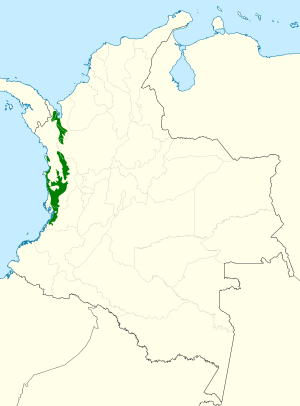Sooty-capped puffbird facts for kids
Quick facts for kids Sooty-capped puffbird |
|
|---|---|
| Conservation status | |
| Scientific classification | |
| Genus: |
Bucco
|
| Species: |
noanamae
|
 |
|
| Synonyms | |
|
Nystactes noanamae |
|
The sooty-capped puffbird (Bucco noanamae) is a type of bird that belongs to the family Bucconidae. This family includes puffbirds, nunlets, and nunbirds. This special bird lives only in Colombia.
Contents
About the Sooty-capped Puffbird
What does the Sooty-capped Puffbird look like?
The sooty-capped puffbird is about 18 centimeters (7 inches) long. Its head and the back of its neck are dark, almost black or grayish-black. It has a bright white stripe above its eye, which turns gray towards the back. A wide black line goes through and below its eye.
Its upper body and short tail are dark brown. The bird has a white chin and a wide black band across its chest. Its belly is a buffy white color with black wavy patterns. The puffbird's beak is black, its eyes are red, and its feet are light gray.
Where do Sooty-capped Puffbirds live?
The sooty-capped puffbird is found only along the coast of Colombia. It lives from the Gulf of Urabá in the north down to the San Juan River in the south.
What is the Sooty-capped Puffbird's habitat?
These birds prefer to live in wet and humid forests. They can be found in both old, untouched forests and newer forests that have grown back. They also live in nearby open areas and scrublands. Sooty-capped puffbirds usually stay low in the trees and bushes. They live from sea level up to about 100 meters (330 feet) high.
How do Sooty-capped Puffbirds behave?
What do Sooty-capped Puffbirds eat?
The sooty-capped puffbird is a hunter! It waits on a low branch and then quickly flies out to catch large insects from leaves. We don't know much more about what else they eat.
How do Sooty-capped Puffbirds reproduce?
Scientists have only found one nest of a sooty-capped puffbird. This nest was inside a termitarium (a termite mound) that was built in a tree. Both parent birds were seen bringing food to their young in the nest.
What sounds do Sooty-capped Puffbirds make?
The sooty-capped puffbird's song is a long series of 20 to 40 whistles. It starts very fast, almost like a trill, and then the whistles become slower and clearer.
Are Sooty-capped Puffbirds in danger?
The IUCN (International Union for Conservation of Nature) has listed the sooty-capped puffbird as "Near Threatened." This means their numbers are decreasing quite quickly. The main reasons for this decline are that their forest homes are being cut down for wood or turned into farms. People building new homes and raising cattle also contribute to the loss of their habitat.
See also
 In Spanish: Buco de Noanamá para niños
In Spanish: Buco de Noanamá para niños


